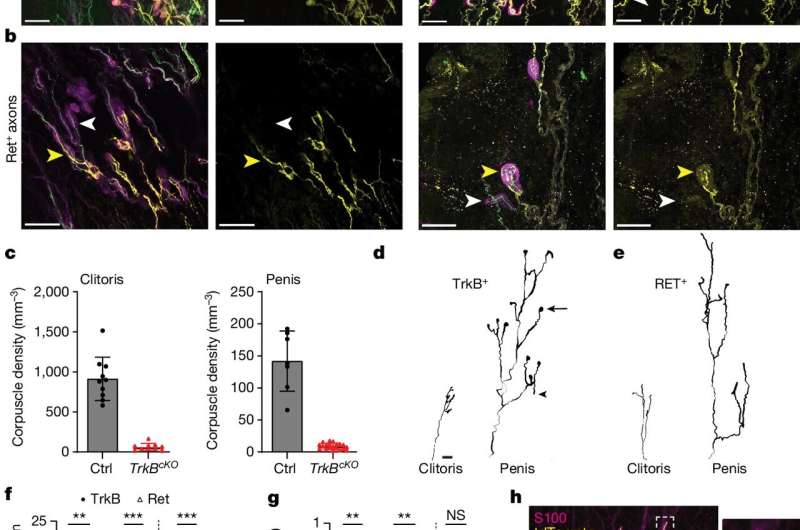June 26, 2024 report
This article has been reviewed according to Science X's editorial process and policies. Editors have highlighted the following attributes while ensuring the content's credibility:
fact-checked
peer-reviewed publication
trusted source
proofread
Taking a closer look at the role Krause corpuscles play in sexual behavior in mice

A team of neurobiologists at Howard Hughes Medical Institute has taken a closer look at Krause corpuscles and learned more about their role in the sexual behavior of mice. In their study, published in the journal Nature, the group analyzed the nerve structure in both the penis and clitoris in mice.
Anastasia-Maria Zavitsanou and Ishmail Abdus-Saboor, with Columbia University, have published a News and Views piece in the same journal issue giving an overview of sensory corpuscles of the genitalia and the work on this new effort.
As noted by Zavitsanou and Abdus-Saboor, the sense of touch is due to activation of nerves embedded in the skin. Prior research has shown that there are a variety of sensory corpuscles in the genitals of humans and many other animals, including mice, though little research has explored how they work and the role they play in sexual behavior.
The Krause corpuscle is a structure that holds clusters of neurons and exists in the skin of both human and mice genitalia. It is known to play a role in sensing touch and vibration. In this new effort, the research team sought to learn more about its structure and the way it behaves when stimulated.
In taking a closer look at several samples of the structures in both male and female mice, the researchers found that they varied in shape but all were wrapped in Schwann cells and connecting tissue. The consistency of the Schwann cells, they found, was such that they allowed the neurons to move slightly when the skin was touched or jostled.
They also discovered two subtypes of the structures that existed in the penis and clitoral skin. And they found that while the neurons had an endpoint in the corpuscle, the other end stretched to the spinal cord at a spot that was different from sites where other skin sensation nerves terminated—a spot that was near to the "spinal ejaculation generator."
The team also tested the responsiveness of the neurons in Krause corpuscles by applying a tool that vibrated at different frequencies. They found the strongest reactions at 40–80 hertz. And finally, they found that the density of Krause corpuscles in the clitoris was approximately 15 times that of the penis.
More information: Lijun Qi et al, Krause corpuscles are genital vibrotactile sensors for sexual behaviours, Nature (2024). DOI: 10.1038/s41586-024-07528-4
Anastasia-Maria Zavitsanou et al, Sex organs sense vibrations through specialized touch neurons, Nature (2024). DOI: 10.1038/d41586-024-01645-w
Journal information: Nature
© 2024 Science X Network





















